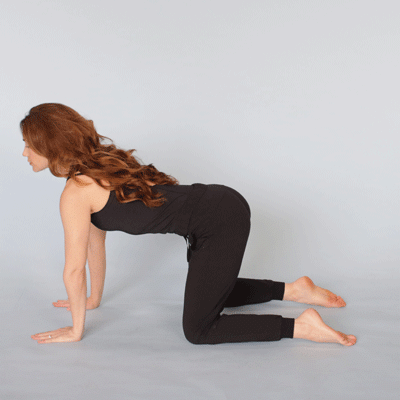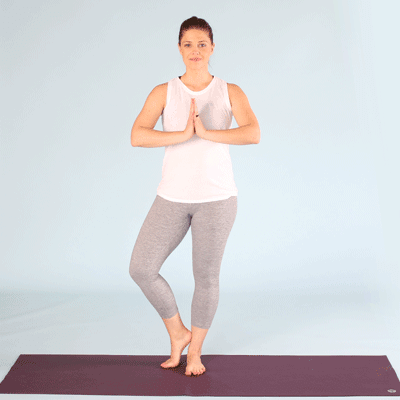Yoga may help reduce stress and anxiety. Through certain poses and breathing techniques, you can learn to manage negative thoughts at your own pace.
Practicing yoga may help reduce symptoms of anxiety. Focusing on both your breath and your ability to be present in each pose can help quiet negative mental chatter and boost your overall mood.
Here are 11 poses demonstrated by Amy White from Active Body. Creative Mind.
This seated posture can help you find your center. Focusing on your breath may help you find ease in the stillness of this pose.
Muscles worked:
- erector spinae
- quadriceps
- knee muscles
- ankle muscles
How to do hero pose
- Start in a kneeling position. Your knees should be together, and your feet should be slightly wider than your hips.
- Keep the tops of your feet flat on the floor.
- Sit back so that your bottom reaches the floor in between your feet. If your bottom does not reach the floor, use a block or a book.
- Place your hands on your thighs.
- Sit up straight to open your chest and lengthen your spine.
- Hold this pose for up to 5 minutes.
This classic standing pose may help you focus inward, quieting racing thoughts.
Muscles worked:
- abdominals
- psoas
- quadriceps
- tibialis anterior
How to do tree pose
- From standing, bear your weight with your right foot and slowly lift your left foot off of the ground.
- Slowly turn the sole of your left foot toward the inside of your left leg.
- Place it on the outside of your left ankle, calf, or thigh.
- Avoid pressing your foot into your knee.
- Bring your hands into any comfortable position. This could be in prayer position in front of your heart or hanging alongside your sides.
- Hold this pose for up to 2 minutes.
- Repeat on the opposite side.
This energizing pose can help ease tension in your neck and back.
Muscles worked:
- latissimus dorsi
- internal oblique
- gluteus maximus and medius
- hamstrings
- quadriceps
How to do triangle pose
- Come into a standing position with your feet wider than your hips.
- Face your left toes forward and your right toes in at a slight angle.
- Lift your arms to extend out from your shoulders. Your palms should face down.
- Extend your torso forward as you reach forward with your left hand.
- Hinge at your hip joint to bring your right hip back. Take your left hand to your leg, the floor, or a block.
- Extend your right arm up toward the ceiling.
- Gaze in any comfortable direction.
- Hold this pose for up to 1 minute.
- Then do the opposite side.
This resting standing pose may help relax your mind while releasing tension in your body.
Muscles worked:
- spinal muscles
- piriformis
- hamstrings
- gastrocnemius
- gracilis
How to do standing forward bend
- Stand with your feet about hip-width apart and your hands on your hips.
- Exhale as you hinge at the hips to fold forward, keeping a slight bend in your knees.
- Drop your hands to the floor or rest them on a block.
- Tuck your chin into your chest.
- Release tension in your lower back and hips. Your head and neck should hang heavy toward the floor.
- Hold this pose for up to one minute.
This backbend can help relieve tightness in your chest and back.
Muscles worked:
- intercostals
- hip flexors
- trapezius
- abdominals
How to do fish pose
- Sit with your legs stretched out in front of you.
- Place your hands underneath your buttocks with your palms facing down.
- Squeeze your elbows together and expand your chest.
- Then lean back onto your forearms and elbows, pressing into your arms to stay lifted in your chest.
- If it’s comfortable, you may let your head hang back toward the floor or rest it on a block or cushion.
- Hold this pose for up to one minute.
This heart-opening pose stretches and lengthens the spine to relieve tension.
Muscles worked:
- deltoids
- trapezius
- erector spinae
- triceps
How to do extended puppy pose
- Come into a tabletop position.
- Extend your hands forward a few inches and sink your buttocks down toward your heels.
- Press into your hands and engage your arms muscles, keeping your elbows lifted.
- Gently rest your forehead on the floor.
- Allow your chest to open and soften during this pose.
- Hold this pose for up to two minutes.
This relaxing pose may help ease stress and fatigue.
Muscles worked:
- gluteus maximus
- rotator muscles
- hamstrings
- spinal extensors
How to do child’s pose
- From a kneeling position, sink back onto your heels.
- Fold forward, walking your hands out in front of you.
- Allow your torso to fall heavy into your thighs, and rest your forehead on the floor.
- Keep your arms extended forward or rest them alongside your body.
- Hold this pose for up to 5 minutes.
This pose may help soothe your nervous system.
Muscles worked:
- groin
- hamstrings
- spinal extensors
- gastrocnemius
How to do head-to-knee forward bend
- Sit on the edge of a cushion or folded blanket with your left leg extended.
- Press the sole of your right foot into your left thigh.
- You can place a cushion or block under either knee for support.
- Inhale as you extend your arms overhead.
- Exhale as you hinge at the hips, lengthening your spine to fold forward.
- Rest your hands anywhere on your body or on the floor.
- Hold this pose for up to 5 minutes.
- Then repeat on the opposite side.
If you feel that your thoughts have been scattered throughout your practice, take this time to turn inward and come back to your intention.
Muscles worked:
- pelvic muscles
- erector spinae
- gluteus maximus
- gastrocnemius
How to do seated forward bend
- Sit on the edge of a folded blanket or cushion with your legs straight out in front of you.
- You may keep a slight bend in your knees.
- Inhale to lift up your arms.
- Slowly hinge at your hips to extend forward, resting your hands anywhere on your body or the floor.
- Remain in this pose for up to 5 minutes.
This restorative pose allows for complete relaxation of your mind and body.
Muscles worked:
- hamstrings
- pelvic muscles
- lower back
- front torso
- back of the neck
How to do legs-up-the-wall pose
- Sit with your right side against a wall.
- Then lie back as your swing your legs up along the wall.
- Your buttocks should be as close to the wall as is comfortable for you. This could be right up against the wall or a few inches away.
- Relax and soften in your back, chest, and neck. Allow your body to melt into the floor.
- Hold this pose for up to 10 minutes.
This relaxing pose can help you let go of anxiety while promoting a sense of calmness. You can make it more of a heart opener by placing a block or cushion under your back.
Muscles worked:
- adductors
- groin muscles
- pelvic muscles
- psoas
How to do reclining bound angle pose
- Lie on your back and bring the soles of your feet together.
- Place cushions under your knees or hips for support.
- Place one hand on your stomach area and one hand on your heart, focusing on your breath.
- Stay in this pose for up to 10 minutes.
You should always talk with your doctor before starting a new yoga or exercise program. They can help you identify any possible risks and recommend appropriate modifications.
Make sure you practice in a space that feels comfortable and safe. If you feel that practicing yoga is triggering your anxiety instead of alleviating it, discontinue the practice.






